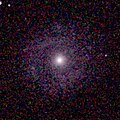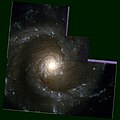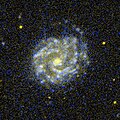| NGC 3631 | |
|---|---|
 NGC 3631 imaged by the Hubble Space Telescope | |
| Observation data (J2000 epoch) | |
| Constellation | Ursa Major |
| Right ascension | 11h 21m 02.8753s [1] |
| Declination | +53° 10′ 11.038″ [1] |
| Redshift | 0.003839 [1] |
| Heliocentric radial velocity | 1151 ± 1 km/s [1] |
| Distance | 33.7 ± 17.7 Mly (10.3 ± 5.4 Mpc) [1] |
| Group or cluster | NGC 3631 Group (LGG 241) |
| Apparent magnitude (V) | 10.1 |
| Characteristics | |
| Type | SA(s)c [1] |
| Size | ~56,700 ly (17.39 kpc) (estimated) [1] |
| Apparent size (V) | 5.0′ × 4.8′ [1] |
| Other designations | |
| Arp 27, UGC 6360, MCG +09-19-047, PGC 34767, VV 363 [1] | |
NGC 3631 is a spiral galaxy located in the constellation Ursa Major. It is located at a distance of about 35 million light years from Earth, which, given its apparent dimensions, means that NGC 3631 is about 60,000 light years across. It was discovered by William Herschel on April 14, 1789. [2] It is a grand design spiral galaxy seen face on.



